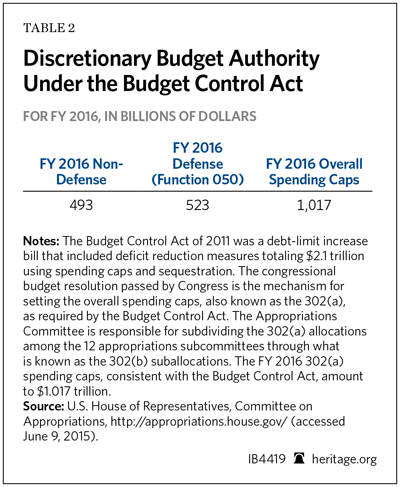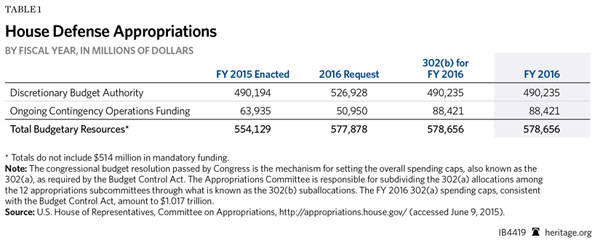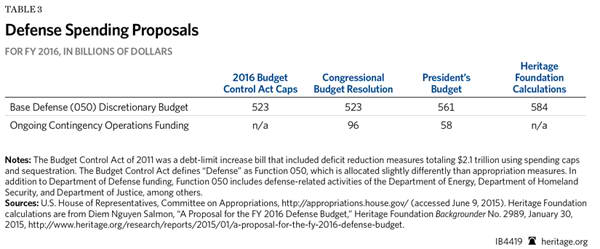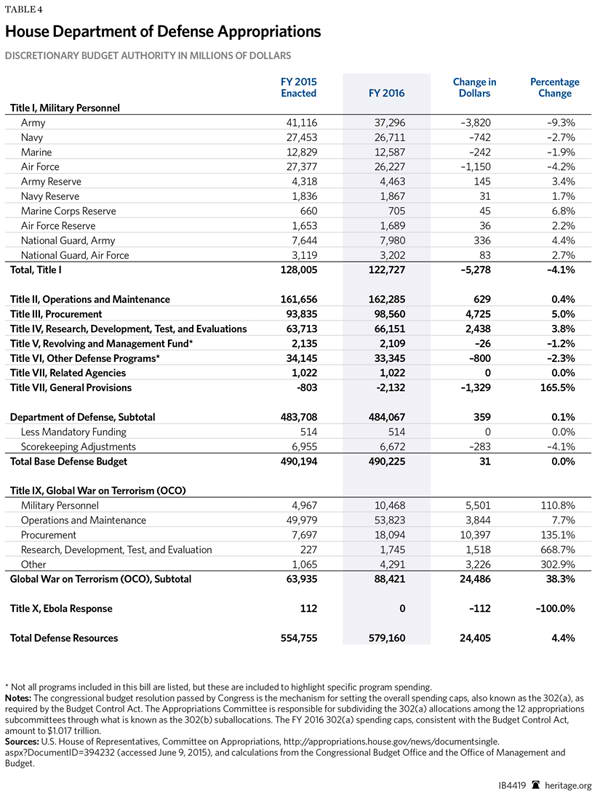This week, the House of Representatives debates the Department of Defense (DoD) appropriations bill, which provides $490.2 billion in discretionary budget authority (BA) for fiscal year (FY) 2016. The levels provided are nearly the same levels as current funding but $37 billion less than the President requested in his budget submission to Congress. However, the bill also provides resources for a fund dedicated to Overseas Contingency Operations (OCO), or war funding. When base discretionary and OCO funds are combined, the total budget authority increases to $579.2 billion—about $800 million above requested levels and $24.4 billion more than current funding.
National security funding is at a critical juncture in Washington. Under the Budget Control Act (BCA), spending is legally divided into two separate spending categories: defense and non-defense (see Table 2). Both are subject to spending caps outlined in the law. Many conservatives believe that by putting disproportionate emphasis on cuts in defense, spending reductions achieved by the BCA have failed to prioritize federal funding adequately.
This categorization provides considerable flexibility in determining domestic, non-defense spending priorities but does little to do the same with defense spending. This situation has left conservatives in a Catch-22 situation, with legislators caught between their desire to provide enhanced funding for new national security resources and the need to adhere to the spending caps. The DoD appropriations bill can do little to realign spending in the defense or non-defense categories. If this appropriations bill attempted to exceed the spending caps outlined in the BCA, that spending would be subject to sequestration.
To circumvent the spending caps, Congress employs a budget gimmick, known as Overseas Contingency Operations (OCO) or war funding, that is meant to provide resources to the ongoing wars in Iraq and Afghanistan. The emergency nature of OCO means those resources are available without the restrictions of BCA spending limits. The resources needed to fulfill the missions of the war are determined—and requested—by the President.
For FY 2016, the President requested $58 billion for OCO, $38 billion less than the $96 billion provided by the congressional budget resolution. The $38 billion in OCO funds above the President’s request is not the appropriate way to address national security needs.
In his June 1, 2015, letter to Appropriations Committee Chairman Hal Rogers (R–KY), Shaun Donovan, Director of the Office of Management and Budget, writes:
[T]he inappropriate use of OCO risks undermining an essential mechanism that both parties have long agreed was meant to fund incremental costs of overseas conflicts and support our troops while in harm’s way. The subcommittee’s deliberate relabeling of non-war costs as OCO clearly violates the OCO funding’s purpose. For instance, the subcommittee bill funds $7 billion in compensation for servicemembers whose billets were not created for temporary operations.[1]
The letter shows that the less than honest use of the OCO fund to provide additional spending to capped accounts is not lost on lawmakers. That said, the intent of Donovan’s letter is not a benevolent fight for the taxpayer against the use of budget gimmicks. Instead, the general intent is to increase the spending cap levels altogether—an approach that conservatives should not consider.
The solution to the problem of national security priorities running up against budget caps can be achieved without budget gimmicks or busting the overall BCA budget caps; it requires a legislative renovation of the BCA, which can be accomplished by removing the spending cap firewall between defense and non-defense. Members of Congress could then act to redirect funds otherwise provided to overreaching, big-government non-defense programs to meet national security priorities.

Department of Defense Recommendations
In March, The Heritage Foundation published “The Budget Book: 106 Ways to Reduce the Size and Scope of Government.”[2] It includes an analysis of the entire budget with recommendations for the Department of Defense. The recommendations provide areas in the defense budget that can be reduced.
- Non-Combat-Related Medical Research. The bill provides $66.2 billion for research, development, testing, and evaluation in FY 2016. Eliminating non-combat-related medical accounts would result in a total reduction of at least $300 million.
- Commissary Subsidies. The bill provides $1.154 billion for commissary salaries for FY 2016, roughly the same as current funding.
- Increases Use of Performance-Based Logistics. The bill provides $162.3 billion for operations and maintenance for FY 2016, $630 million more than current funding. Using performance-based logistics in weapon system maintenance and sustainment would reduce funding by $9 billion.
In January, the Heritage Foundation published “A Proposal for the FY 2016 Defense Budget,”[3] which includes recommended actions in the following areas:
- Increase National Defense Spending. The bill provides $490 billion in base DoD spending for FY 2016, roughly the same as current funding.[4] There are two general concepts for “defense” in Congress: One refers to the Department of Defense, as is the case with this bill, and the other refers to an esoteric budget concept that defines defense as “Function 050.”
Function 050 is a defense account that funds not only DoD, but also any security-related spending, including the Department of Energy’s National Nuclear Security Administration, among others. It is the defense Function 050 account that is subject to a statutory BCA spending cap, which is $523 billion for FY 2016, $490 billion of which—as in this DoD bill—is provided for DoD defense activities as opposed to related security activities. The Heritage Foundation recommends that the funds provided for defense (Function 050) be increased from $523 billion to $584 billion. The $584 billion increase would include the following within DoD:- Increase Personnel and Force Size Funding. The bill provides military personnel $122.7 billion for FY 2016, $5.3 billion less than current funding. Stopping the Army personnel cuts would take $2.3 billion, and preserving the Marine Corps personnel numbers would cost $398 million.
- Increase Procurement or Research and Development Funding. The bill provides Procurement $98.6 billion, $2 billion more than current funding.
- Increase Operations Funding. The bill provides Operation and Maintenance $162.3 billion, $630 million more than current funding.
Conclusion
The House Department of Defense appropriations bill is part of the ongoing debate over BCA budget cap levels. The bill highlights the difficult decisions before Congress in balancing fiscal responsibility and national security priorities.
After years of unsustainable trillion-dollar deficits, the budget caps put in place by the BCA were arguably the first real step in reigning in out-of-control spending. For this reason, we cannot afford to stymie progress by meddling with the current overall spending limits. At the same time, conservative Members of Congress are concerned that the funding limits reducing defense spending will jeoparidize national security. Balancing the preservation of the overall spending caps and providing new resources to defense is a topic that will continue to be dealt with in future spending bills.
—John Gray is a Research Fellow in Federal Fiscal Affairs in the Thomas A. Roe Institute for Economic Policy Studies, of the Institute for Economic Freedom and Opportunity, at The Heritage Foundation.





